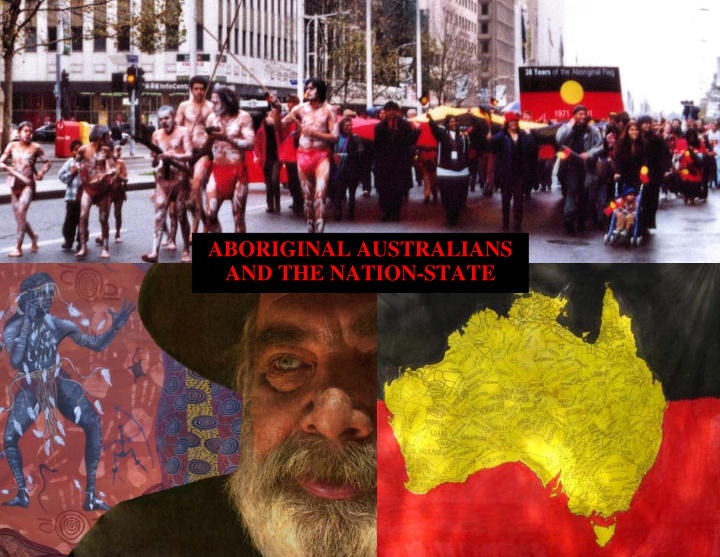



ABORIGINAL AUSTRALIANS AND THE NATION-STATE
INTRODUCTION � Urban Aboriginals led national activism � Adopted the dominant organizational formats and techniques � The early phase: integrationist, seeking equal rights as citizens of Australia � Later: Aboriginal rights � Civil Rights – Black Power – Aboriginal rights struggles Main landmarks in modern Aboriginal political history: Early Aboriginal Political Organization on the National Level: The Fight for Rights as Australian Citizens � late 1950s, Federal Council for the Advancement of Aborigines and Torres Strait Islanders (FCAATSI) 2
� FCAATSI’s five main principles: 1: Equal citizenship rights with other Australian citizens for aborigines. 2: All aborigines to have a standard of living adequate for health and well being, including food, clothing, housing and medical care not less than for other Australians. 3: All aborigines to receive equal pay for equal work and the same industrial protection as other Australians. 4: Education for detribalised aborigines to be free and compulsory. 5: The absolute retention of all remaining native reserves, with native communal or individual ownership. Early questions—assimilation via citizenship, or “integration”? “What does assimilation imply? Certainly, citizenship and equal status—so far, so good; but also the disappearance of the Aboriginals as a separate cultural group, and ultimately their physical absorption by the European part of the population ... We feel that the word ‘ integration ’ implies a truer definition of our aims and objects.” (FCAATSI’s inaugural congress, 1958) 3
LANDMARKS IN THE ABORIGINAL POLITICAL STRUGGLE 1960s The Freedom Ride, 1965 Charles Perkins } (See also: http://tinyurl.com/d4ntxuk) � Student Action for Aborigines (SAFA) 4
Wave Hill, 1966 � Newcastle Waters and Wave Hill cattle stations in the Northern Territory � Industrial action had been transformed into a claim for land by the Gurindji � Yolngu on Gove Peninsula, 1969, challenged “terra nullius The 1967 Referendum � Section 127 of the Federal Constitution, on the Census, stated: “In reckoning the numbers of people of the Commonwealth or of a State, or other part of the Commonwealth, Aboriginal natives shall not be counted.” RIGHTS OF ABORIGINES ON SETTLEMENTS AND RESERVES IN 5 STATES & THE NORTHERN TERRITORY: NSW VIC SA WA NT QLD Voting Rights (State) Yes Yes Yes No Yes No Marry Freely Yes Yes Yes No No No Control Own Children Yes Yes No No No No Move Freely Yes No No No No No Own Property freely Yes No Yes No No No Receive Equal Wages Yes No No No No No Alcohol Allowed No No No No No No 5
� May 1967 referendum, 93% of Australian voters agreed to count Aboriginals along with all other citizens � From political rights, civil liberties, to Aboriginal cultural rights, self- determination 1970s-1980s � Aboriginal nationhood and sovereignty � Gough Whitlam (Australia Labour Party), reforms of 1972: social spending, land rights (Northern Territory), Aboriginal-managed legal & medical services � Founding of National Aboriginal Consultative Committee (NACC) Gough Whitlam 6
� Shift from protest to management � Rising expectations � falling expectations, rise in protest � No real self-determination � NACC, not grounded in Aboriginal culture � An alternative? Northern and Central Land Councils, founded in 1973 and 1977 Black Power and Aboriginal Identity: New Aboriginal Organizations � National Tribal Council � Black Panthers of Australia (1970) [see also: http://tinyurl.com/c54ygyg and http://tinyurl.com/cwg4ba2] 7
The Tent Embassy, 1972 “We Demand 1. Full State rights to the Northern Territory under Aboriginal ownership and control with all titles to minerals, etc. 2. Ownership of all other reserves and settlements throughout Australia with all titles to minerals and mining rights. 3. The preservation of all sacred lands not included in Points 1. and 2. 4. Ownership of certain areas of certain cities with all titles to minerals and mining rights. 5. As compensation, an initial payment of six billion dollars for all other land throughout Australia plus a percentage of the gross national income per annum.” (See also: http://tinyurl.com/cctq37u and http://indigenousrights.net.au/section.asp?sID=12) 8
MABO: 1982-1992 � 10 year legal battle to overturn “terra nullius” � Won at the Supreme Court in 1992 � Recognition of the prior sovereignty of Indigenous Peoples, a right “as against the whole world” to possess their lands � Lands, where Native Title had not been formally extinguished, were to be returned � Most obvious beneficiaries: rural Aboriginal communities Eddie Koiki Mabo 9
WIK � December 1996, “the Wik Decision,” High Court in Canberra: Pastoral leases may not have extinguished native title—but, recognized the rights of both pastoral leaseholders and prospective native title holders 1990s � Aboriginal and Torres Strait Islander Commission (ATSIC): new political and administrative structures (disbanded the following decade, in 2005) � Council for Aboriginal Reconciliation—The Key Issues of Reconciliation, 1994 (please see: http://tinyurl.com/d7cvtrx) � Increased conflict, under the government of John Howard � Recolonization of the Northern Territory? Under the guise of humanitarian intervention. 10
Recommend
More recommend